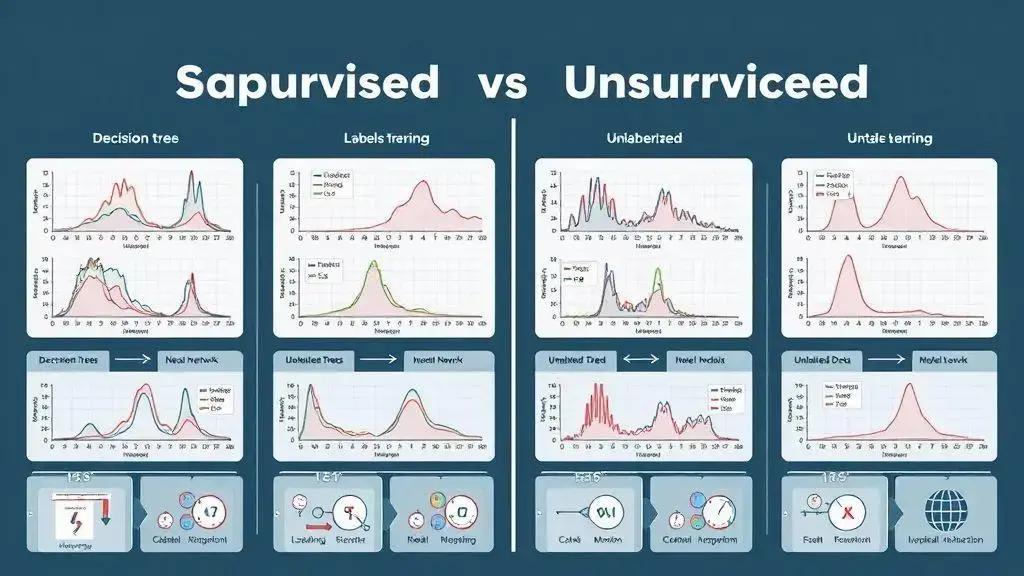Supervised vs unsupervised ML 2025: which to choose?

Supervised vs unsupervised ML in 2025 will focus on enhanced automation, personalization of experiences, and ethical AI development, leading to significant advancements across various industries.
Supervised vs unsupervised ML 2025 can feel a bit overwhelming, can’t it? As machine learning evolves, knowing which approach suits your needs is crucial. Let’s dive into the distinctions that could shape your future projects.
Understanding supervised learning techniques
Understanding supervised learning techniques is essential for anyone venturing into the world of machine learning. This approach relies on labeled data and aims to map input data to correct outputs. By providing a clear set of examples, machines can learn patterns and make predictions with impressive accuracy.
How Supervised Learning Works
In supervised learning, an algorithm analyzes labeled datasets, which consist of input-output pairs. For instance, if you want to predict house prices, you may include features like size, location, and number of bedrooms as inputs, with the actual prices serving as the outputs. This method allows the algorithm to understand the relationship between inputs and their corresponding outputs.
Examples of Supervised Learning Techniques
- Linear Regression: This technique predicts a continuous value, such as prices or temperatures, based on the relationship between variables.
- Logistic Regression: Used for classification tasks, it predicts the probability of a binary outcome.
- Decision Trees: This model splits data into branches to make predictions based on feature values, resembling a flowchart.
- Support Vector Machines: This method finds the hyperplane that best separates different classes within the data.
By employing these techniques, organizations can analyze vast amounts of data to identify trends and patterns. The success of supervised learning often relies on the quantity and quality of the labeled data provided. Without sufficient and clear labeling, the algorithm’s predictions may lack accuracy.
Another critical aspect is evaluating the model’s performance. Techniques such as cross-validation can be used to ensure that the learning algorithm generalizes well to unseen data. Achieving high accuracy is great, but it should not come at the expense of overfitting, where the model performs well on training data but poorly on new inputs.
Embracing supervised learning can significantly enhance decision-making processes. With the right techniques, businesses can leverage data intelligently, enabling them to respond promptly to user needs, market shifts, and transformative opportunities.
Exploring unsupervised learning methods
Exploring unsupervised learning methods opens up vast possibilities in data analysis. Unlike supervised learning, unsupervised learning doesn’t require labeled outputs. Instead, it looks for patterns and structures within the input data.
How Unsupervised Learning Works
In unsupervised learning, algorithms process data without any labels, allowing them to discover hidden relationships. Think about clustering similar items or detecting anomalies within data. This approach helps uncover insights that may not be visible at first glance.
Common Unsupervised Learning Techniques
- K-Means Clustering: This technique groups data points into clusters based on similarity, allowing for easy identification of patterns.
- Hierarchical Clustering: By building a tree of clusters, this method helps visualize data relationships and how they connect.
- Principal Component Analysis (PCA): This technique reduces data dimensionality while preserving variance, making complex data easier to analyze.
- Association Rule Learning: This method discovers interesting relationships among variables in large databases, like shopping cart analysis.
Unsupervised learning is pivotal in various fields, including marketing, healthcare, and finance. For instance, marketers use clustering to identify customer segments, ensuring targeted strategies. In healthcare, it aids in grouping patients with similar symptoms for better diagnosis.
The ability to work with unlabeled data makes unsupervised learning particularly valuable when labels are scarce or too expensive to obtain. By analyzing patterns in the data, organizations can make informed decisions, driving innovation and efficiency.
Key differences between supervised and unsupervised ML

Understanding the key differences between supervised and unsupervised ML is crucial for effectively applying these methods to various problems. While both techniques fall under the umbrella of machine learning, they serve distinct purposes and require different approaches.
Definition and Purpose
In supervised learning, the model is trained using labeled data. This means each input data point has a corresponding output, allowing the algorithm to learn from examples. In contrast, unsupervised learning deals with unlabeled data. Here, the model attempts to identify patterns and structures without specific guidance.
Data Requirements
- Supervised Learning: Requires a significant amount of labeled data to train effectively.
- Unsupervised Learning: Operates on unlabeled data, making it valuable when gathering labels is difficult or expensive.
Another major difference lies in how these methods handle data. Supervised learning is effective for prediction tasks, where the goal is to forecast outcomes based on input data. Meanwhile, unsupervised learning is used primarily for discovering hidden structures and insights, such as clustering users based on behavior.
Applications
When it comes to practical applications, understanding these differences can lead to better outcomes. In industries like finance, supervised learning might predict credit scores or fraud based on historical data. On the other hand, unsupervised learning can be used to segment customers for targeted marketing without predefined categories.
Overall, recognizing the key distinctions between supervised and unsupervised ML enables organizations to choose the right method for their needs, driving innovation and efficiency in data analysis.
Applications of supervised and unsupervised ML in 2025
Applications of supervised and unsupervised ML in 2025 are expected to evolve significantly as technology advances. Both techniques are being utilized in diverse fields, revolutionizing how businesses operate and make decisions.
Supervised Learning Applications
In 2025, supervised learning will continue to play a critical role in areas such as finance, healthcare, and marketing. For instance, in finance, predictive algorithms help detect fraud by analyzing transaction patterns and flagging unusual activities. In healthcare, supervised learning aids in diagnosing diseases based on patient records and symptoms.
- Predictive Analytics: Businesses will use supervised learning to forecast sales and customer behavior.
- Image Recognition: This technology will enhance security systems by identifying individuals in real-time.
- Sentiment Analysis: Companies will analyze social media sentiment to refine their marketing strategies.
Unsupervised Learning Applications
On the other hand, unsupervised learning will gain traction in various sectors. It is particularly valuable for uncovering hidden patterns within large datasets. For example, retailers will use clustering techniques to segment customers based on shopping habits, leading to personalized marketing.
In 2025, unsupervised methods will also enhance anomaly detection in cybersecurity, spotting potential threats before they escalate. Additionally, industries will implement unsupervised learning for recommendation systems, offering users tailored suggestions based on their behavior.
As organizations leverage both supervised and unsupervised learning, they will unlock new insights and efficiencies, shaping the future landscape of decision-making and innovation.
Future trends in machine learning: what to expect
Future trends in machine learning are poised to shape various industries dramatically. As technology evolves, the capabilities of machine learning are expanding, opening doors to new innovations and applications.
Increased Automation
One major trend is the rise of automation in processes across sectors. In 2025 and beyond, businesses will increasingly rely on machine learning to automate repetitive tasks. This allows human workers to focus on more complex and creative functions, improving overall efficiency.
- Data Processing: Automated data management systems will use ML to analyze and organize vast datasets quickly.
- Customer Service: AI-driven chatbots will handle inquiries, providing instant support and improving user experience.
- Predictive Maintenance: Industries will adopt ML to predict when machinery is likely to fail, reducing downtime.
Enhanced Personalization
Another critical area of focus will be personalization. Companies are utilizing machine learning to create tailored experiences for their customers. By analyzing behavior and preferences, businesses can offer personalized recommendations and services.
In the retail space, shoppers will see customized suggestions that make their shopping experience more enjoyable. Likewise, streaming platforms will provide suggestions based on viewing habits, ensuring users find content that suits their tastes.
Ethical AI Development
As machine learning proliferates, so does the need for ethical development. In the coming years, organizations will prioritize the responsible use of AI. This includes addressing bias in algorithms and ensuring fair treatment across different demographics.
Moreover, transparency in AI decisions is becoming essential. Users will demand clarity on how decisions are made, particularly where privacy and security are concerned. This ethical focus will guide machine learning’s evolution, making it more trustworthy.
In summary, the future trends in machine learning will revolve around automation, personalization, and ethical practices. Staying aware of these trends will help businesses adapt and innovate effectively, leveraging machine learning to their advantage.
In conclusion, machine learning continues to grow and impact various industries. As we look ahead, we can expect significant advancements in automation, personalized experiences, and ethical developments. Embracing these trends will not only enhance efficiency but also foster innovation and trust in technology. Staying updated with these changes will help businesses leverage machine learning effectively for future success.
FAQ – Frequently Asked Questions about Machine Learning Trends
How will automation improve my business efficiency?
Automation allows your team to focus on complex tasks while repetitive activities are handled by machine learning systems, resulting in increased productivity.
What role does personalization play in customer satisfaction?
Personalization helps tailor experiences to individual customer preferences, making them feel valued and enhancing their overall satisfaction with your brand.
Why is ethical AI development important?
Ethical AI development ensures fairness, transparency, and responsibility in AI use, helping to build trust with customers and avoid biases in decision-making.
What future trends can we expect in machine learning?
Future trends in machine learning will focus on increased automation, enhanced personalization, and ethical practices that reshape industries and consumer interactions.





